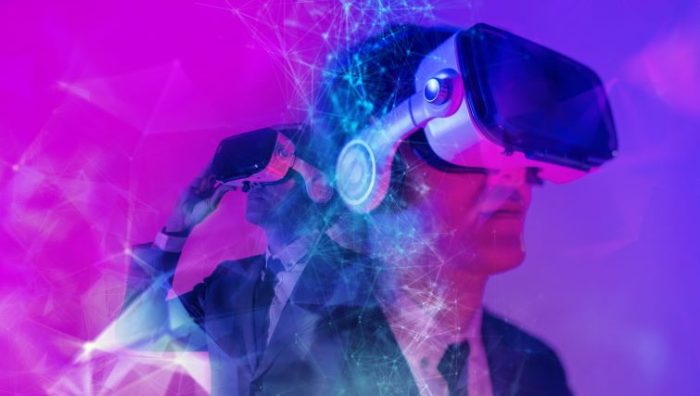Why Virtual Reality Training is The Future of Company Upskilling
 Publié le 2 October 2023
Publié le 2 October 2023
With all the benefits of employers and employees alike, it’s easy to see why virtual reality training is the future of company upskilling.
Just a decade ago, virtual reality training would have sounded like science fiction to most people. Now, it’s something that many of us have heard a lot about, and some even experienced through gaming and other spaces where virtual reality is growing, such as art museums.
The scope of virtual reality has the potential to be almost as vast as the scope of our actual reality. And with such an impetus placed on upskilling in the workplace, VR offers an exciting avenue to help employees quickly learn important aspects of their role in realistic yet safe situations. Taking a closer look at the benefits offered can make it clear why virtual reality is the future of company upskilling.
What VR Includes
Interaction possibilities within VR include the following:
Hand-held controllers
Remote control software devices with buttons and joysticks are available. These are not dissimilar to game controllers. These are user-friendly and intuitive, and quick to get used to.
Eye tracking
The technology inside headsets can track where the user is looking so that the scene adapts to the user’s visual cues.
Hand tracking
Cameras attached to headsets are able to track users’ hand movements so that the user can interact with the VR world with their hands.
Voice control
Just like Siri or Alexa, in VR, voice control allows you to speak directly to the system.
Body tracking
This technology can track the position of your entire body so that you feel fully immersed in the VR environment.
Image sourced from grandviewresearch.com
Benefits of VR Training
In this section, we’ll outline the core benefits of virtual reality training. We will cover areas such as affordability, accessibility, safety, and more! With so many benefits it will be easy to see why virtual reality training is the future of company upskilling.
Accessibility
If you have seen the movie ‘Avatar,’ you might remember that one of the main characters was in a wheelchair. Yet, through the use of technology with elements of virtual reality, he could run and explore another world and interact with objects as if he were there in person.
Virtual reality in gaming has also become much more common and offers a similar experience to anyone with access to the hardware. You can explore various worlds from the comfort of a 2-by-2-meter space on your living room floor while your dog watches you with confusion.
It should come as no surprise then that virtual reality can also be used for company training. Remote access tools such as VR sets allow for training that might otherwise require traveling to another country or which would be inaccessible to employees for a variety of reasons. Implementing VR training for upskilling can create a whole new level of accessibility in the workplace.
Increased employee engagement & retention
Free-to-use image sourced from Unsplash
Since VR training is highly interactive, it is more engaging for employees than traditional learning methods, inevitably leading to increased information retention rates. Rather than logging on to a dedicated website, say with co.il domains, to start an arduous online course, employees can don a headset and dive right in.
Learners can explore and interact with virtual simulations in VR environments. This creates more enjoyable and exciting learning and onboarding experiences, which makes retaining the information taught easier.
This commitment to training can also positively affect workplace retention rates and engagement on a day-to-day level. Since employees generally prefer employers who show that they care about the professional development of their staff, offering VR training can boost employee satisfaction.
Continuous training, including soft skills, can make a company attractive to employees.
The company comes across as innovative and committed to the development of its employees.
Cost-effective
Since companies don’t have to arrange corporate travel, overnight stays, and meals for their employees to attend training events, VR training is a much more cost-effective alternative to many traditional training sessions. Companies also don’t have to worry about hiring a trainer to come to their offices.
You can use VR training sessions over and over again and tweak them for different circumstances, so companies are unlikely to need to create training programs from scratch or invest in custom-made ones. And the companies that have the need and the budget for custom training sessions also tend to be large enough that it’s worth the investment to train all of their employees.
Environmentally-conscious
Free-to-use image sourced from Unsplash
Given that employees and customers can greatly care about the environmental impact of an organization , the environmental cost of our business actions needs to be calculated and any harm mitigated. Companies can further reduce their carbon footprint by offering a training option with minimal travel requirements. Instead of the 0.681 tons of carbon emitted by one employee on a round-trip flight from Chicago to Boston in business class, the amount of CO2 emitted from a VR training session is virtually negligible.
And as computing becomes increasingly more energy-efficient, these differences will become even more exciting. For future employees researching your company, it might be a plus if you offer VR training as part of your eco-strategy.
Access to expert skills & niche knowledge
Running training sessions in person is complex. You need to research people to give the training, you need to pay them, and you need to find and pay for a venue unless you have space in-house. You often need to supply food. In other words: it’s expensive. But the trickiest part is being limited to the skills and expertise of just one or two trainers.
Virtual reality opens the door to a much vaster horizon of knowledge. As the world gradually moves in the direction of VR, more and more expertise will enter this realm and become accessible to a wider audience.
Instead of heavy investments in a couple of people with knowledge of one subject, training will cost no more than hiring VR equipment and any fees to access the training program.
Free-to-use image sourced from Unsplash
Compact and modular learning
Virtual reality training is also much more compact than traditional training, with information condensed into one place, modules to explore, and the freedom to move at your own pace through the material. Whereas a trainer will present the information at their own pace, with VR, each employee can move at a speed they feel comfortable with. This is essential for employees upskilling on the job.
They can also revisit old chapters, a little like rewinding a YouTube video to go over missed or confusing parts. This will help them learn the skills needed to excel at their job role, and do it at the speed that works best for them.
Safe learning environment
Another great advantage of VR training is that it offers learners a safe, controlled learning environment. VR training offers a virtual environment where employees can make mistakes and learn without any real-world consequences. VR training offers a safe place to fail.
VR simulations give learners a chance to practice skills and develop them, witnessing what would happen in different situations as a result of their actions, but without the real-world consequences that would otherwise ensue. Scenario-based learning offers a safe space where employees can make sense of training experiences.
This is particularly useful for high-risk situations, creating a familiarity that leads to more informed choices and better reactions in real-world cases.
Call center agents can get practice using VoIP call center software with virtual customers, and sales teams can practice pitching to customers. Healthcare workers can practice interacting with virtual patients before having to take part in important conversations with real patients.
It’s not just surgeons who can make use of VR. Anyone, from the lowest-risk environments to the highest-stake situations, can improve their performance in a zero-risk VR setting.
Realistic learning experiences
Free-to-use image sourced from Unsplash
Another benefit of VR training is the fact that it can offer users learning scenarios that are emotionally realistic. Employee training software can seamlessly integrate with VR technology, enhancing the effectiveness of training programs.
E-learning tools and formats such as PowerPoint presentations or info videos can be a little lackluster and struggle to engage their audience. Making in-person role-playing sequences using actors feel realistic is also pretty tough. Learners are likely to feel awkward or watched during this kind of simulation.
VR training offers an alternative to these situations that has the ability to engage and stimulate learners emotionally. VR allows employees to experience the real emotions that would occur in a real-world workplace scenario.
Your personal philosophy on coaching plays an important role in creating effective VR training experiences. By tailoring scenarios to align with your coaching principles, you can ensure that learners are immersed in situations that resonate with your training approach and learning objectives.
This could allow a customer service agent to experience the stress they could face and have to manage while talking with an upset customer. By offering emotionally realistic scenarios and experiences, VR allows employees to learn how to self-regulate so they can keep their cool in the real world. A simulated conversation featuring emotionally realistic role-play can be employed for this end.
VR can help you train both hard and soft skills, such as non-verbal communication, the latter using virtual human characters with realistic mannerisms, speech, and body language.
Company Upskilling: The Future is Virtual
Virtual reality training is undoubtedly going to become more popular in companies everywhere. While it might seem a little niche at the moment, as the technology improves and costs go down, it will provide a safe training environment.
With realistic scenarios that you can customize for individual departments and access to a plethora of different subjects, it’s easy to see why virtual reality training is the future of company upskilling. And unlike traditional training sessions, you can easily access VR from different locations, and it is more accessible to people who can’t travel very easily.







